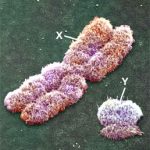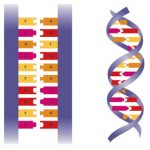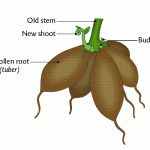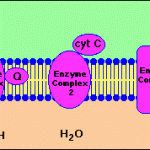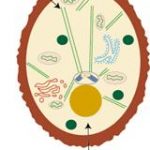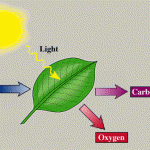Contents
Read our Genetics (Ordinary Level) page before moving on to this page.
Gregor Mendel
Gregor Mendel studied 7 characteristics of pea plants. He studied:

As a result of Mendel’s work the study of genetics began. He discovered that, although an organism may have genotypes for 2 different physical traits (phenotypes) the organism will only exhibit one of those traits.
The work he did for the height of the plants is a follows:
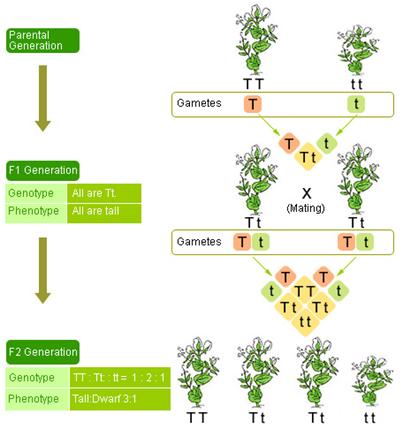
He discovered although the parents of the first generation had TT and tt genotypes all the progeny of the F1 generation were tall.
He then discovered that in the F2 generation there was a 3:1 ratio between tall and short.
The Punnett Square for Mendel’s F1 generation is:
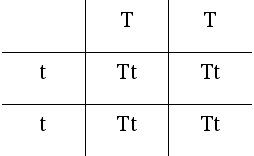
The Punnett Square for Mendel’s F2 generation is:
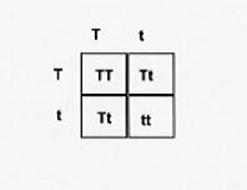
Note that in the F1 generation the parents were homozygous. One was TT and one was tt. All the progeny were tall because all the progeny had Tt genotypes with T being the dominant characteristic.
In the F2 generation a Tt plant was used to self-pollinate itself. All of the phenotypes in this combination were Tt. As a result the F2 progeny were 3 Tt and1 tt.
Mendel’s Laws
First Law- The Law of Segregation
1. This law states:
a. In diploid organisms, chromosomes occur in matching pairs. These pairs are called homologous chromosomes. These are chromosomes that pair at meiosis, have the same length and banding pattern plus carrying the same genes at the same locus. They have the same sequence of genes.
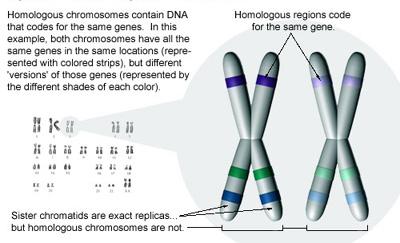
Notice that these two chromosomes are homologous because they have alleles at the same position on the chromosome but one allele is for purple flowers and the other for white flowers.
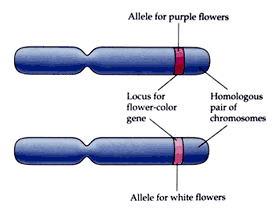
b. For each characteristic or trait organisms inherit two alternative forms of that gene, one from each parent. These alternative forms of a gene are called alleles.
c. When gametes (sex cells) are produced, allele pairs separate or segregate leaving them with a single allele for each trait.
d. When the two alleles of a pair are different, one is dominant and the other is recessive.
Example:
If your eyes are blue, green or grey you have two alleles for blue eyes (bb), then your gametes must have a blue allele (b); if your eyes are brown you might have two brown allele (BB), then your gametes have one allele for brown (B) or you might have one allele of each kind (Bb), in which case you make two kinds of gametes some contain the brown allele (B) and some contain the blue allele (b).
Second Law – Law of Independent Assortment
Mendel’s Second Law involves dihybrid crosses. Dihybrid crossing involves the study of 2 characteristics at the same time.The Law of Independent Assortment states that alleles for different traits are distributed to sex cells (& offspring) independently of one another.
Mendel noticed during all his work that the height of the plant and the shape of the seeds and the color of the pods had no impact on one another. In other words, being tall didn’t automatically mean the plants had to have green pods, nor did green pods have to be filled only with wrinkled seeds, the different traits seem to be inherited independently.
The genotypes of our parent pea plants will be:
RrGg x RrGg where
“R” = dominant allele for round seeds
“r” = recessive allele for wrinkled seeds
“G” = dominant allele for green pods
“g” = recessive allele for yellow pods
Notice that we are dealing with two different traits: (1) seed texture (round or wrinkled) & (2) pod color (green or yellow). Notice also that each parent is hybrid for each trait (one dominant & one recessive allele for each trait).
We need to “split” the genotype letters & come up with the possible gametes for each parent. Keep in mind that a gamete (sex cell) should get half as many total letters (alleles) as the parent and only one of each letter. So each gamete should have one “R or r” and one “G or g” for a total of two letters. There are four possible letter combinations: RG, Rg, rG, and rg. So, when the two parents’ gametes form a new organism the punnett square will look like this:
|
|
RG |
Rg |
rG |
rg |
|
|
RG |
RRGG |
RRGg |
RrGG |
RrGg |
|
|
Rg |
RRGg |
RRgg |
RrGg |
Rrgg |
|
|
rG |
RrGG |
RrGg |
rrGG |
rrGr |
|
|
Rg |
RrGg |
Rrgg |
rrGg |
rrgg |
|
The results from a dihybrid cross are always the same:
9/16 boxes (offspring) show dominant phenotype for both traits (round & green),
3/16 show dominant phenotype for first trait & recessive for second (round & yellow),
3/16 show recessive phenotype for first trait & dominant form for second (wrinkled & green), &
1/16 show recessive form of both traits (wrinkled & yellow).
So, as you can see from the results, a green pod can have round or wrinkled seeds, and the same is true of a yellow pod. The different traits do not influence the inheritance of each other. They are inherited INDEPENDENTLY.
Interesting to note is that if you consider one trait at a time, we get “the usual” 3:1 ratio of a single hybrid cross (like we did for the Law of Segregation). For example, just compare the color trait in the offspring; 12 green & 4 yellow (3:1 dominant: recessive). The same deal with the seed texture; 12 round & 4 wrinkled (3:1 ratio). The traits are inherited INDEPENDENTLY of each other.
SUMMARY OF MENDEL’S LAWS
|
LAW |
PARENT |
OFFSPRING |
|
DOMINANCE |
TT x tt |
100% Tt |
|
SEGREGATION |
Tt x Tt |
75% tall |
|
INDEPENDENT ASSORTMENT |
RrGg x RrGg |
9/16 round seeds & |
Linkage (Gene Linkage)
Gene linkage occurs when traits for 2 separate characteristics occur on the same chromosome.
The characters Mendel examined happened to be on separate chromosomes. That is why he observed independent assortment. If, however, the genes are on the same chromosomes, they will be inherited together. For example, consider the following parental nuclei. Both father and mother have a pair of chromosomes with alleles for two different genes:
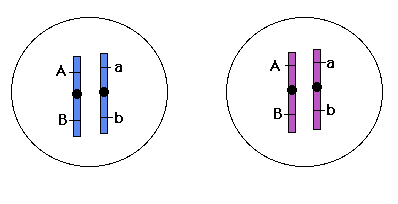
If we look at this with a punnet square what is going to happen in the next generation:
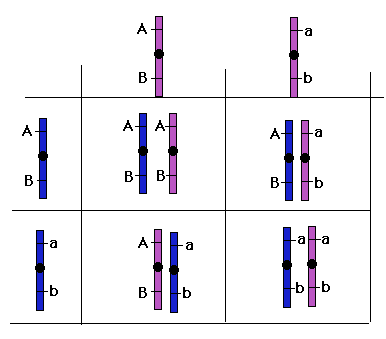
The phenotype ratios are still 3:1, but there are fewer genotype combinations than in the usual cross involving two alleles.
Remember: With independent assortment the phenotypes resulted in a 9:3:3:1 ratio.
Sex-linked Genes or Sex linkage
Genes or traits whose controlling genes are on the X sex chromosome but not on the Y sex chromosome. As a result recessive phenotype occurs more often in males than in females.
There is yet another, unrelated, special case that means something totally different, yet has a similar-sounding name. This is sex-linked genes, genes located on one of the sex chromosomes (X or Y) but not the other. Since, typically the X chromosome is longer, it bears a lot of genes not found on the Y chromosome, and thus most sex-linked genes are X-linked genes. One example of a sex-linked gene is fruit fly eye colour. An X chromosome carrying a normal, dominant, red-eyed allele would be symbolized by a plain X, while the recessive, mutant, white-eyed allele would be symbolized by X’ or Xw. A fly with genotype XX’ would normally be a female with red eyes, yet be a carrier for the white-eyed allele. Because a male typically only has one X chromosome, he would normally be either XY and have normal, red eyes or X’Y and have white eyes. The only way a female with two X chromosomes could have white eyes is if she would get an X’ allele from both parents making her X’X’ genotype. The cross between a female carrier and a red-eyed male would look like this:
|
|
X |
Y |
||||
|
X |
|
|||||
|
X’ |
||||||
Notice that while there is a typical ratio of red-eyed to white-eyed, all of the white-eyed flies are males.
Sex-linked traits act just like recessive ones except they also bow to the will of the sex of the child. Genes are carried on things called chromosomes. Most people already know that in humans the man has an X and Y chromosome and the female has two X chromosomes. This is the reason that only the man can determine the sex of the child. Women can only provide X chromosomes while a man can provide either. Now, the X chromosome is bigger and can carry more genetic information on it than the Y can.
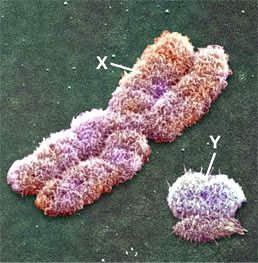
This is where sex-linked traits come in. Because the X is bigger it means that some genes carried on it are not carried on the Y chromosome. These genes can be expressed even without a corresponding partner on an X chromosome. They also cannot be blocked out unless there is another X chromosome carrying a dominant partner.
In humans, two well-known X-linked traits are haemophilia and red-green colour-blindness. Haemophilia is the failure (lack of genetic code) to produce certain substance needed for proper blood-clotting, so a haemophiliac’s blood doesn’t clot, and (s)he could bleed to death from an injury that a normal person might not even notice.
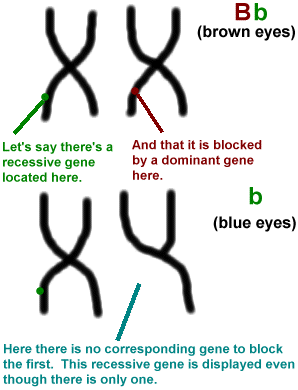
One human sex-linked trait is Haemophilia. Haemophilia is a disease that keeps a person’s blood from clotting when he is cut. Haemophiliacs can easily bleed to death and must be very careful not to injure themselves. Many also take daily injections to help the problem. Because haemophilia is a sex-linked disease most of the people who have it are men. Women can carry the gene for haemophilia but will not be affected by it because their second X chromosome will block it out with a healthy gene. They must have two copies of the defective gene to display the disease. Inheriting two copies is highly unlikely. Men carrying haemophilia do not have another X chromosome so they will have haemophilia with only one gene for it. Mothers carrying one gene for haemophilia take a great risk with having children because there is a 50% chance their sons will end up with the disease. Here’s how it works:
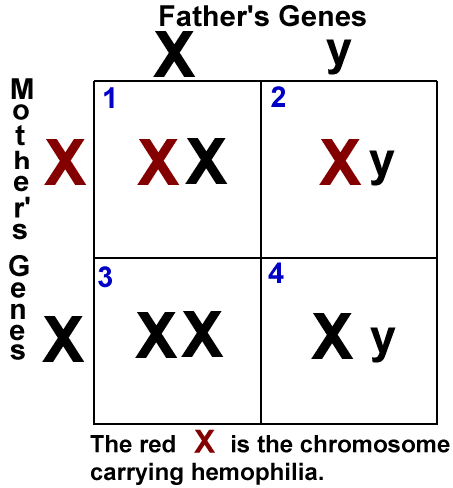
As you can see, at least half of her children (boxes 1 and 2) will inherit the defective gene. One, a daughter, will only carry the gene. The other, a son, will have the disease haemophilia. The last two children (boxes 3 and 4) will carry healthy genes. Of course these are only the possibilities of what her children could end up with. She could very well end up giving it to all her children or none at all. It’s just a matter of chance. Now let’s take a look at what will happen if this woman’s haemophiliac son has children with a healthy woman:
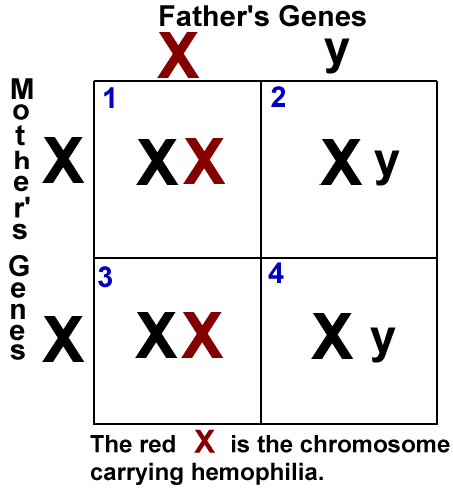
In this case half the children will still inherit the gene. All the sons will be safe but all the daughters will end up carrying haemophilia and could end up passing it on to their children. It is in this way that sex-linked genes can disappear and reappear from generation to generation.
Review Questions
1. Which of the following is a possible abbreviation for a genotype?
A. BC
B. Pp
C. Ty
D. fg
2. What is the best way to determine the phenotype of the feathers on a bird?
A. analyze the bird’s DNA (genes)
B. look at the bird’s feathers
C. look at the bird’s beak
d. examine the bird’s droppings
3. Which of the following pairs is not correct?
A. kk = hybrid
B. hybrid = heterozygous
C. heterozygous = Hh
D. homozygous = RR
4. The genes present in an organism represent the organism’s __________.
A. genotype
B. phenotype
C. physical traits
5. Which choice represents a possible pair of alleles?
A. k & t
B. K & T
C. K & k
D. K & t
6. How many alleles for one trait are normally found in the genotype of an organism?
A. 1
B. 2
C. 3
D. 4
7. Which statement is not true?
A. genotype determines phenotype
B. phenotype determines genotype
C. a phenotype is the physical appearance of a trait in an organism
D. alleles are different forms of the same gene
8. Which cross would best illustrate Mendel’s Law of Segregation?
A. TT x tt
B. Hh x hh
C. Bb x Bb
D. rr x rr
9. In the cross Yy x Yy, what percent of offspring would have the same phenotype as the parents?
A. 25%
B. 50%
C. 75%
D. 100%
10. In a certain plant, purple flowers are dominant to red flowers. If the cross of two purple-flowered plants produces some? purple-flowered and some red-flowered plants, what is the genotype of the parent plants?
A. PP x Pp
B. Pp x Pp
C. pp x PP
D. pp x pp
Base questions #11-14 on the following information:
A white-flowered plant is crossed with a pink-flowered plant. All of the F1 offspring from the cross are white.
11. Which phenotype is dominant?
12. What are the genotypes of the original parent plants?
13. What is the genotype of all the F1 offspring?
14. What would be the percentages of genotypes & phenotypes if one of the white F1 plants is crossed with a pink-flowered plant?
15. Which of Mendel’s Laws is/are illustrated in this question?
16. Crossing two dihybrid organisms results in which phenotypic ratio?
A. 1:2:1
B. 9:3:3:1
C. 3:1
D. 1:1
17. The outward appearance (gene expression) of a trait in an organism is referred to as:
A. genotype
B. phenotype
C. an allele
D. independent assortment
18. In the homologous chromosomes shown in the diagram, which is a possible allelic pair?
A. cD
B. Ee
C. AB
D. ee
19. The phenotype of a pea plant can best be determined by:
A. analyzing its genes
B. looking at it
C. crossing it with a recessive plant
D. eating it
20. Mendel formulated his Law of Segregation after he had:
A. studied F1 offspring
B. studied F2 offspring
C. produced mutations
D. produced hybrids
21. Which cross would produce phenotypic ratios that would illustrate the Law of Dominance?
A. TT x tt
B. TT x Tt
C. Tt x Tt
D. tt x tt
22. The mating of two curly-haired brown guinea pigs results in some offspring with brown curly hair, some with brown straight hair, some with white curly hair, and even some with white straight hair. This mating illustrates which of Mendel’s Laws?
A. Dominance
B. Segregation
C. Independent Assortment
D. Sex-Linkage
Answers
1. Which of the following is a possible abbreviation for a genotype?
A. BC
B. Pp – genotypes are made up of 2 of the same letter (either 2 capital, 2 lowercase, or one of each)
C. Ty
D. fg
2. What is the best way to determine the phenotype of the feathers on a bird?
A. analyze the bird’s DNA (genes)
B. look at the bird’s feathers – “phenotype of the feathers” means what the feathers look like, so look at them
C. look at the bird’s beak
d. examine the bird’s droppings
3. Which of the following pairs is not correct?
A. kk = hybrid – Kk would be hybrid (one capital, one lowercase of the same letter)
B. hybrid = heterozygous
C. heterozygous = Hh
D. homozygous = RR
4. The genes present in an organism represent the organism’s __________.
A. genotype – X
B. phenotype
C. physical traits
5. Which choice represents a possible pair of alleles?
A. k & t
B. K & T
C. K & k – allele means 2 forms of the same gene. so this choice shows 2 forms of the same letter K or k
D. K & t
6. How many alleles for one trait are normally found in the genotype of an organism?
A. 1
B. 2 – one allele is inherited from each parent
C. 3
D. 4
7. Which statement is not true?
A. genotype determines phenotype – (note that the environment does play a role in influencing phenotype too)
B. phenotype determines genotype – X
C. a phenotype is the physical appearance of a trait in an organism
D. alleles are different forms of the same gene – (see question #5)
8. Which cross would best illustrate Mendel’s Law of Segregation?
A. TT x tt
B. Hh x hh
C. Bb x Bb – both parent show dominant trait, but some recessive offspring will be produced (each parent carries a “b”)
D. rr x rr
9. In the cross Yy x Yy, what percent of offspring would have the same phenotype as the parents?
A. 25%
B. 50%
C. 75% – in the completed p-square, 3 of 4 boxes will have at least 1 “Y”, producing the dominant phenotype (same as parents)
D. 100%
10. In a certain plant, purple flowers are dominant to red flowers. If the cross of two purple-flowered plants produces some? purple-flowered and some red-flowered plants, what is the genotype of the parent plants?
A. PP x Pp
B. Pp x Pp – for any offspring to be recessive, each parent MUST have at least one “p”
C. pp x PP – only one parent is purple, this CAN’T be an answer
D. pp x pp – neither parent is purple, this CAN’T be an answer
Base questions #11-15 on the following information:
A white-flowered plant is crossed with a pink-flowered plant. All of the F1 offspring from the cross are white.
11. Which phenotype is dominant? white
12. What are the genotypes of the original parent plants? WW (pure white) x ww (pink)
13. What is the genotype of all the F1 offspring? Ww (white)
14. What would be the percentages of genotypes & phenotypes if one of the white F1 plants is crossed with a pink-flowered plant?
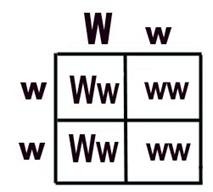
50% heterozygous white & 50% homozygous recessive pink.
The cross for this question would be “Ww (white F1) x ww (pink)”.
The alleles of the white parent are above the columns & those of the pink parent are in front of the rows. 2 of 4 boxes (50%) are “Ww”, which is heterozygous & would have the dominant trait (white). The other 2 of 4 boxes (50%) are “ww”, which is homozygous recessive & would have the recessive trait (pink).
15. Which of Mendel’s Laws is/are illustrated in this question? Dominance is illustrated by the original cross (WW x ww).
16. Crossing two dihybrid organisms results in which phenotypic ratio?
A. 1:2:1 – genotype ratio of a hybrid cross, ex: Tt x Tt
B. 9:3:3:1- dihybrid means hybrid for two different traits. An example could be GgYy x GgYy.
C. 3:1 – phenotype ratio of a hybrid cross
D. 1:1
17. The outward appearance (gene expression) of a trait in an organism is referred to as:
A. genotype
B. phenotype – X
C. an allele
D. independent assortment
18. In the homologous chromosomes shown in the diagram, which is a possible allelic pair?
A. cD
B. Ee- a possible allelic pair but NOT SHOWN IN THE DIAGRAM, so this CAN’T be an answer
C. AB
D. ee – an “allelic pair” is always two forms of the same letter. In this example they are two lowercase “e’s”.
19. The phenotype of a pea plant can best be determined by:
A. analyzing its genes
B. looking at it – X
C. crossing it with a recessive plant
D. eating it
20. Mendel formulated his Law of Segregation after he had:
A. studied F1 offspring –
B. studied F2 offspring – he crossed two hybrids (F1’s) and got a second generation — the F2. – X
C. produced mutations – Mendel knew NOTHING about mutations so this CAN’T be an answer
D. produced hybrids
21. Which cross would produce phenotypic ratios that would illustrate the Law of Dominance?
A. TT x tt – one parent tall, the other short, all offspring would be tall – X
B. TT x Tt
C. Tt x Tt – illustrates Segregation
D. tt x tt
22. The mating of two curly-haired brown guinea pigs results in some offspring with brown curly hair, some with brown straight hair, some with white curly hair, and even some with white straight hair. This mating illustrates which of Mendel’s Laws?
A. Dominance
B. Segregation
C. Independent Assortment – the question involves two different traits (hair color & hair texture), this is the only law that deals with two different traits
D. Sex-Linkage – Mendel knew NOTHING about sex-linkage so this CAN’T be an answer
Punnett Square Practice
QUESTION #1
Let’s say that in seals, the gene for the length of the whiskers has two alleles. The dominant allele (W) codes long whiskers & the recessive allele (w) codes for short whiskers.
a) What percentage of offspring would be expected to have short whiskers from the cross of two long-whiskered seals, one that is homozygous dominant and one that is heterozygous?
b) b) If one parent seal is pure long-whiskered and the other is short-whiskered, what percent of offspring would have short whiskers?
QUESTION #2
In purple people eaters, one-horn is dominant and no horn is recessive. Draw a Punnett Square showing the cross of a purple people eater that is hybrid for horns with a purple people eater that does not have horns. Summarize the genotypes & phenotypes of the possible offspring.
QUESTION #3
A green-leafed luboplant (not a real plant) is crossed with a luboplant with yellow-striped leaves. The cross produces 185 green-leafed luboplants. Summarize the genotypes & phenotypes of the offspring that would be produced by crossing two of the green-leafed luboplants obtained from the initial parent plants.
QUESTION #4
Mendel found that crossing wrinkle-seeded plants with pure round-seeded plants produced only round-seeded plants. What genotypic & phenotypic ratios can be expected from a cross of a wrinkle-seeded plant & a plant heterozygous for this trait (seed appearance)?
Punnett Square Solutions
Punnett Square Solutions Question #1
In seals, the gene for the length of the whiskers has two alleles. The dominant allele (W) codes long whiskers & the recessive allele (w) codes for short whiskers.
a) What percentage of offspring would be expected to have short whiskers from the cross of two long-whiskered seals, one that is homozygous dominant and one that is heterozygous? ANSWER: 0%.
I personally like to write down the info given in the question on my paper first. So I start by writing:
W = allele for long whiskers
w = allele for short whiskers
A homozygous dominant seal would be “WW” (homozygous dominant = 2 CAPITAL letters).
A heterozygous seal would be “Ww” (heterozygous = 1 CAPITAL & 1 lowercase).
The cross is in the question therefore: WW x Ww.
The Punnett Square would look like this:
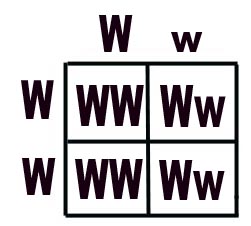
The possible gametes from the homozygous parent seal are on the left in front of the rows, & the possible gametes from the heterozygous parent are above the columns. We fill in the boxes by copying “one letter from the left, one letter from the top”.
Analyzing our results, we find that 50% of our offspring (2 of 4 boxes) are “WW”, and 50% (2 of 4 boxes) are “Ww”. In terms of phenotype (what they would look like) 100% would have long whiskers (because all of the offspring have at least one “W”, which codes for long whiskers).
So the answer to question 1a is: 0% would have short whiskers. The only way to have short whiskers is to be “ww”, and that combo is not possible from the parents in this cross.
b) If one parent seal is pure long-whiskered and the other is short-whiskered, what percent of offspring would have short whiskers? ANSWER: 0%.
Again, I suggest starting by defining symbols like so:
W = allele for long whiskers
w = allele for short whiskers
“Pure” is the same as homozygous, so “pure long-whiskered” would be “WW”.
If you’re a seal, the only way to have short whiskers is to have the homozygous recessive genotype, in other words be “ww”.
So our cross is: WW x ww.
The Punnett Square would be:
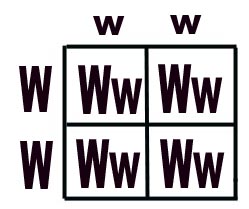
The alleles from the long-whiskered parent (WW) are out in front of the rows (at the left), & the alleles of the short-whiskered parent are above the columns. By the way, we could switch that around & it would not change our answer at all. What I’m saying is: it doesn’t matter where you put the parents (top or side).
Anyway, all our offspring (4 of 4 boxes) have the same genotype: “Ww” & would all end up with long whiskers. To summarize the offspring:
genotype = 100% heterozygous (Ww)
phenotype = 100% long-whiskered.
So our answer to Question 1b is also: 0% would be short-whiskered.
TIP:
In any cross involving at least one parent that is homozygous dominant (2 CAPITAL letters), 100% of the offspring will have the dominant trait in their phenotype.
This is illustrated by Questions 1a & 1b.

